ESP Acura Integra 2000 Sedan Owner's Manual
[x] Cancel search | Manufacturer: ACURA, Model Year: 2000, Model line: Integra, Model: Acura Integra 2000Pages: 273, PDF Size: 4.4 MB
Page 3 of 273
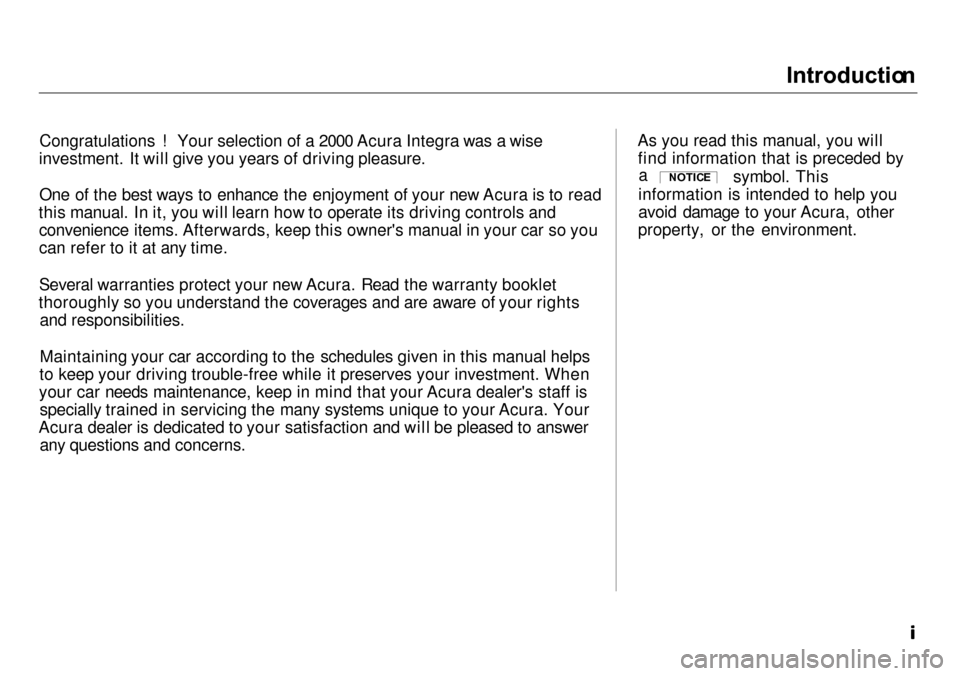
Introductio
n
Congratulations ! Your selection of a 2000 Acura Integra was a wise
investment. It will give you years of driving pleasure.
One of the best ways to enhance the enjoyment of your new Acura is to read
thi
s manual. In it, you will learn how to operate its driving controls and
convenience
items. Afterwards, keep this owner's manual in your car so you
can
refer to it at any time.
Several
warranties protect your new Acura. Read the warranty booklet
thoroughly so you understand the coverages and are aware of your rights and responsibilities.
Maintaining your car according to the schedules given in this manual helps
to keep your driving trouble-free while it preserves your investment. When
your
car needs maintenance, keep in mind that your Acura dealer's staff is
specially
trained in servicing the many systems unique to your Acura. Your
Acura dealer is dedicated to your satisfaction and will be pleased to answer any
questions and concerns. As you read this manual, you will
find
information that is preceded by
symbol.
This
information is intended to help you
avoid damage to your Acura, other
property,
or the environment.
a
NOTIC E
Page 4 of 273
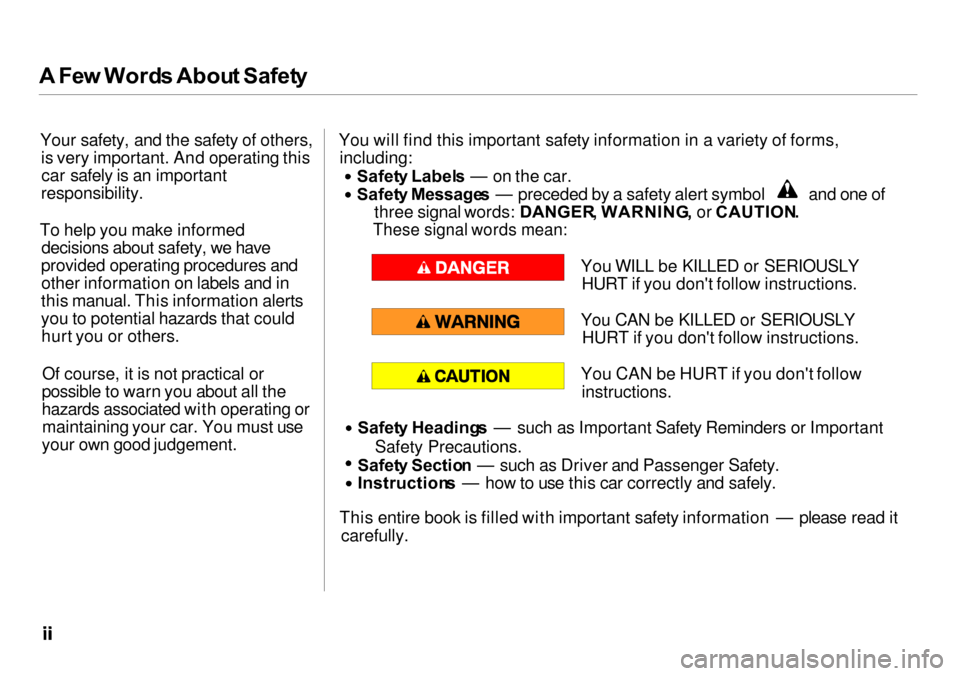
A
Fe w Word s Abou t Safet y
Your safety, and the safety of others, is very important. And operating thiscar safely is an important
responsibility.
To help you make informed decisions about safety, we have
provided operating procedures and other information on labels and in
this manual. This information alerts
you to potential hazards that could hurt you or others.
Of course, it is not practical or
possible to warn you about all the
hazards associated with operating or maintaining your car. You must use
your own good judgement. You will find this important safety information in a variety of forms,
including: Safet
y Label s — on the car. Safet
y Message s — preceded by a safety alert symbol and one of
three signal words: DANGER , WARNING , or CAUTION .
These signal words mean:
You WILL be KILLED or SERIOUSLYHURT if you don't follow instructions.
You CAN be KILLED or SERIOUSLY HURT if you don't follow instructions.
You CAN be HURT if you don't follow instructions. Safet
y Heading s — such as Important Safety Reminders or Important
Safety Precautions. Safet
y Sectio n — such as Driver and Passenger Safety. Instruction
s — how to use this car correctly and safely.
This entire book is filled with important safety information — please read it carefully.
Page 9 of 273
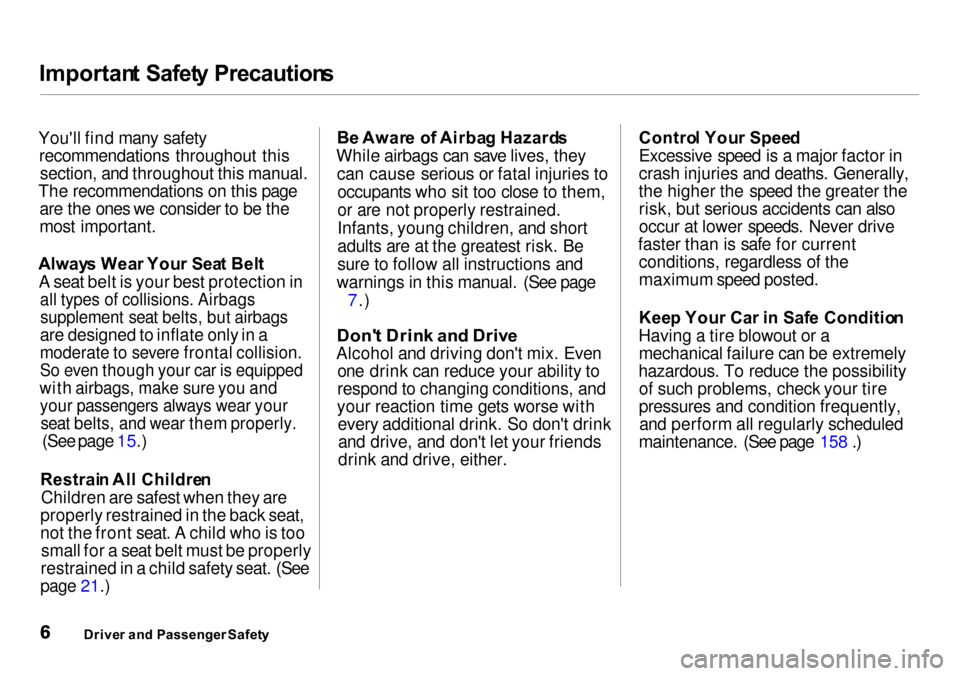
Importan
t Safet y Precaution s
You'll find many safety recommendations throughout thissection, and throughout this manual.
The recommendations on this page are the ones we consider to be the
most important.
Alway s Wea r You r Sea t Bel t
A seat belt is your best protection in
all types of collisions. Airbags
supplement seat belts, but airbags
are designed to inflate only in a
moderate to severe frontal collision.
So even though your car is equipped
with airbags, make sure you and
your passengers always wear your
seat belts, and wear them properly.
(See page 15.)
Restrai n Al l Childre n
Children are safest when they are
properly restrained in the back seat,
not the front seat. A child who is too small for a seat belt must be properly
restrained in a child safety seat. (See
page 21.) B
e Awar e o f Airba g Hazard s
While airbags can save lives, they can cause serious or fatal injuries tooccupants who sit too close to them,
or are not properly restrained.
Infants, young children, and short
adults are at the greatest risk. Be
sure to follow all instructions and
warnings in this manual. (See page 7.)
Don' t Drin k an d Driv e
Alcohol and driving don't mix. Even one drink can reduce your ability to
respond to changing conditions, and
your reaction time gets worse with every additional drink. So don't drinkand drive, and don't let your friends
drink and drive, either. Contro
l You r Spee d
Excessive speed is a major factor in
crash injuries and deaths. Generally,
the higher the speed the greater the risk, but serious accidents can also
occur at lower speeds. Never drive
faster than is safe for current conditions, regardless of the
maximum speed posted.
Kee p You r Car i n Saf e Conditio n
Having a tire blowout or a mechanical failure can be extremely
hazardous. To reduce the possibility of such problems, check your tire
pressures and condition frequently,and perform all regularly scheduled
maintenance. (See page 158 .)
Drive r an d Passenger Safet y
Page 15 of 273

Protectin
g Adult s
Introductio n
The following pages provide instructions on how to properly
protect the driver and other adult
occupants.
These instructions also apply to children who have outgrown childseats and are large enough to wear
lap/shoulder belts. (See page 37 for
important additional guidelines on
how to properly protect larger children.)
1 . Clos e an d Loc k th e Door s
After everyone has entered the car, be sure the doors
are closed and locked. Your car has a door monitor light on
the instrument panel to indicate
when a specific door is not tightly
closed.
For safety, locking the doors reduces
the chance that a passenger,
especially a child, will open a door
while the car is moving and accidentally fall out. It also reducesthe chance of someone being thrown
out of the car during a crash.
For security, locked doors can
prevent an outsider from unexpectedly opening a door when
you come to a stop.
See page 72 for how to lock the
doors.
2.Adjus
t th e Fron t Seat s
Any driver who sits too close to the steering wheel is at risk of being
seriously injured or killed by striking
the steering wheel, or from being struck by an inflating airbag during a
crash.
Drive r an d Passenge r Safet y
Page 24 of 273
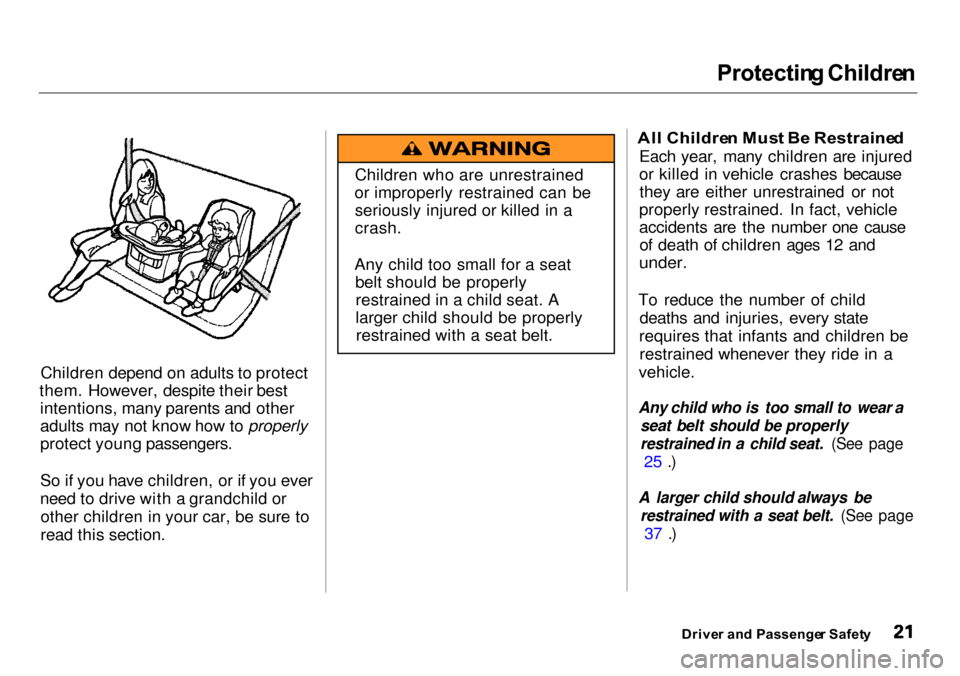
Protectin
g Childre n
Children depend on adults to protect
them. However, despite their best intentions, many parents and other
adults may not know how to properly
protect young passengers.
So if you have children, or if you ever
need to drive with a grandchild or
other children in your car, be sure to
read this section.
Al
l Childre n Mus t B e Restraine d
Each year, many children are injured
or killed in vehicle crashes because they are either unrestrained or not
properly restrained. In fact, vehicle
accidents are the number one cause of death of children ages 12 and
under.
To reduce the number of child deaths and injuries, every state
requires that infants and children be restrained whenever they ride in a
vehicle.
Any child who is too small to wear a seat belt should be properly
restrained in a child seat. (See page
25 .)
A larger child should always be restrained with a seat belt. (See page
37 .)
Driver an d Passenge r Safet y
Children who are unrestrained
or improperly restrained can be seriously injured or killed in a
crash.
Any child too small for a seat belt should be properlyrestrained in a child seat. A
larger child should be properlyrestrained with a seat belt.
Page 49 of 273

Additiona
l Informatio n Abou t You r SR S
Since both airbags use the same
sensors, both airbags normally
inflate at the same time. However, it
is possible for only one airbag to inflate.
This can occur when the severity of
a collision is at the margin, or
threshold, that determines whether
or not the airbags will deploy. In
such cases, the seat belt will provide
sufficient protection, and the supplemental protection offered by
the airbag would be minimal.
After inflating, the airbags
immediately deflate, so they won't
interfere with the driver's visibility,or the ability to steer or operate
other controls.
The total time for inflation and
deflation is approximately one-tenth
of a second, so fast that most
occupants are not aware that the
airbags deployed until they see them lying in their laps. After a crash, you may see what
looks like smoke. This is actually
powder from the airbag's surface.
Although the powder is not harmful,
people with respiratory problems
may experience some temporary
discomfort. If this occurs, get out of
the car as soon as it is safe to do so.
For additional information on how
your airbags work, see the booklet
titled SRS: What You Need to Know
About Airbags that came with yourowner's manual.
Drive r an d Passenge r Safet y
Page 73 of 273

Key
s an d Lock s
If the system repeatedly does not
recognize the coding of your key, contact your Acura dealer.
This indicator will also blink several times when you turn the ignition
switch from ON (II) to ACCESSORY
(I) or LOCK (0).
Do not attempt to alter this system
or add other devices to it. Electrical
problems could result that may make your car undriveable.
If you have lost your key and you cannot start the engine, contact your
Acura dealer. As required by the FCC:
This device complies with Part 15 of the
FCC rules. Operation is subject to the
following two conditions: (1) This device
may not cause harmful interference, and (2) this device must accept any
interference received, including
interference that may cause undesired
operation.
Changes or modifications not expressly approved by the party responsible for
compliance could void the user's
authority to operate the equipment.
This device complies with Industry
Canada Standard RSS-210.
Operation is subject to the following two
conditions: (1) this device may not cause interference, and (2) this device must
accept any interference that may cause undesired operation of the device. Ignitio
n Switc h
The ignition switch is on the right
side of the steering column. It has
four positions: LOCK (0)
ACCESSORY (I)
ON (II)
START (III)
Instrument s an d Control s
Page 107 of 273
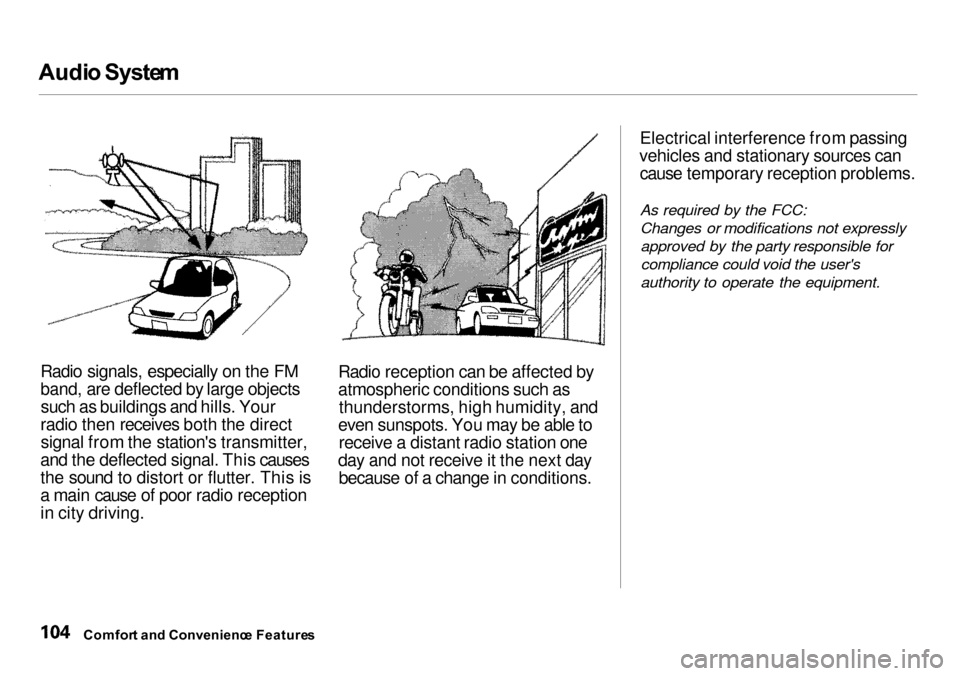
Audi
o Syste m
Radio signals, especially on the FM
band, are deflected by large objects such as buildings and hills. Your
radio then receives both the direct signal from the station's transmitter,
and the deflected signal. This causes
the sound to distort or flutter. This is
a main cause of poor radio reception
in city driving. Radio reception can be affected by
atmospheric conditions such as
thunderstorms, high humidity, and
even sunspots. You may be able to receive a distant radio station one
day and not receive it the next day because of a change in conditions. Electrical interference from passing
vehicles and stationary sources can cause temporary reception problems.
As required by the FCC:Changes or modifications not expressly approved by the party responsible forcompliance could void the user's
authority to operate the equipment.
Comfor t an d Convenienc e Feature s
Page 148 of 273
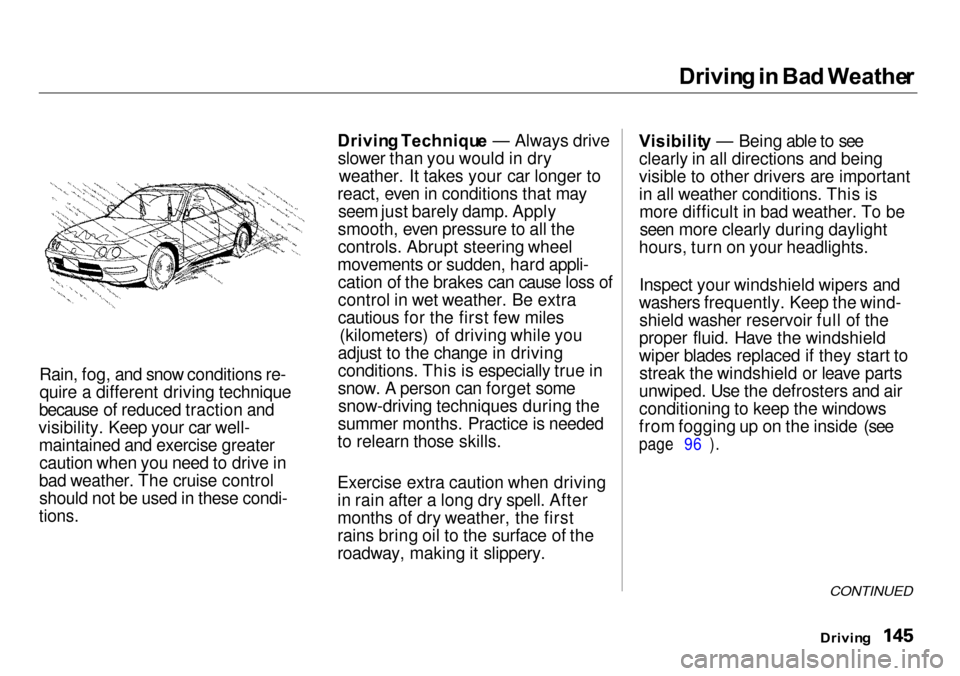
Drivin
g in Ba d Weathe r
Rain, fog, and snow conditions re- quire a different driving technique
because of reduced traction and
visibility. Keep your car well- maintained and exercise greatercaution when you need to drive in
bad weather. The cruise control should not be used in these condi-
tions.
Drivin
g Techniqu e — Always drive
slower than you would in dry weather. It takes your car longer to
react, even in conditions that may seem just barely damp. Apply
smooth, even pressure to all the
controls. Abrupt steering wheel
movements or sudden, hard appli- cation of the brakes can cause loss of
control in wet weather. Be extra
cautious for the first few miles (kilometers) of driving while you
adjust to the change in driving
conditions. This is especially true in
snow. A person can forget some snow-driving techniques during the
summer months. Practice is needed
to relearn those skills.
Exercise extra caution when driving
in rain after a long dry spell. After
months of dry weather, the first
rains bring oil to the surface of the
roadway, making it slippery. Visibilit
y — Being able to see
clearly in all directions and being
visible to other drivers are important
in all weather conditions. This is more difficult in bad weather. To beseen more clearly during daylight
hours, turn on your headlights.
Inspect your windshield wipers and
washers frequently. Keep the wind- shield washer reservoir full of the
proper fluid. Have the windshield
wiper blades replaced if they start to streak the windshield or leave parts
unwiped. Use the defrosters and air
conditioning to keep the windows
from fogging up on the inside (see
page 96 ).
CONTINUED
Drivin g
Page 177 of 273

Coolin
g Syste m
Do not add any rust inhibitors or other additives to your car's coolingsystem. They may not be compatible
with the coolant or engine compo-
nents.
Replacin g Engin e Coolan t
The cooling system should be completely drained and refilled with
new coolant according to the time
and distance recommendations in
the maintenance schedule. Only use Genuine Honda Antifreeze/Coolant.
Draining the coolant requires access to the underside of the car. Unless
you have the tools and knowledge,
you should have this maintenance done by a skilled mechanic. 1. Turn the ignition ON (II). Slide
the heater temperature controllever to maximum heat. Turn theignition off.
2. Open the hood. Make sure the engine and radiator are cool to the
touch.
3. Remove the radiator cap. 4. Loosen the drain plug on the
bottom of the radiator. Thecoolant will drain through thesplash guard. Remove the drain
bolt and washer from the engine
block.
Maintenanc e DRAI
N
BOL T
DRAIN PLU G